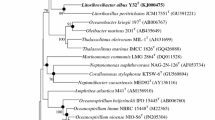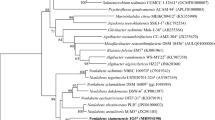Abstract
A Gram-stain-negative, strictly aerobic, beige-pigmented, motile, chemoheterotrophic, rod-shaped or ovoid bacterium, designated strain KMU-37T, was isolated from seawater at Najeong Beach in the Republic of Korea. Phylogenetic analysis based on the 16S rRNA gene sequence revealed that the novel isolate was affiliated with the genus Litorivivens, class Gammaproteobacteria, showing highest sequence similarity (97.4%) to Litorivivens lipolytica HJTF-7T. The DNA–DNA relatedness values between strains KMU-37T and L. lipolytica HJTF-7T were 11.5 ± 0.4%. The DNA G+C content of strain KMU-37T was determined to be 53.8 mol%. Ubiquinone 8 (Q-8) was the sole respiratory quinone. The predominant cellular fatty acids were C17:1 ω8c and C16:1 ω7c and/or C16:1 ω6c. Strain KMU-37T had phosphatidylethanolamine, phosphatidylglycerol and an unidentified lipid as polar lipids. From the distinct phylogenetic position and combination of genotypic and phenotypic characteristics, the strain is considered to represent a novel species of the genus Litorivivens for which the name Litorivivens aequoris sp. nov. is proposed. The type strain of L. aequoris sp. nov. is KMU-37T (= KCCM 90262T = NBRC 111904T).

Similar content being viewed by others
References
Atlas RM (2010) Handbook of microbiological media, 4th edn. CRC, Boca Raton
Bianchi A, Bianchi M (1995) Bacterial diversity and ecosystem maintenance: an overview. In: Hawksworth DL, Colwell RR (eds) Microbial diversity and ecosystem maintenance. CAB International (UNEP), Wallingford, pp 185–198
Collins MD, Jones D (1981) A note on the separation of natural mixtures of bacterial ubiquinones using reverse-phase partition thin-layer chromatography and high performance liquid chromatography. J Appl Bacteriol 51:129–134
Felsenstein J (1985) Confidence limits on phylogenies: an approach using the bootstrap. Evolution 39:783–791
Garrity GM, Bell JA, Lilburn T (2005) Phylum XIV. Proteobacteria phyl. nov. class III. Gammaproteobacteria class. nov. In: Brenner DJ, Krieg NR, Staley JT, Garrity GM (eds) Bergey’s manual of systematic bacteriology, 2nd edn, vol 2. Springer, New York, p 1
Giovannoni SJ, Rappé M (2000) Evolution, diversity, and molecular ecology of marine prokaryotes. In: Kirchman D (ed) Microbial ecology of the oceans. Wiley, New York, pp 47–84
Hansen GH, Sørheim R (1991) Improved method for phenotypical characterization of marine bacteria. J Microbiol Methods 13:231–241
Kim OS, Cho YJ, Lee K, Yoon SH, Kim M, Na H, Park SC, Jeon YS, Lee JH, Yi H, Won S, Chun J (2012) Introducing EzTaxon-e: a prokaryotic 16S rRNA gene sequence database with phylotypes that represent uncultured species. Int J Syst Evol Microbiol 62:716–721
Kimura M (1980) A simple method for estimating evolutionary rates of base substitutions through the comparative studies of sequence evolution. J Mol Evol 16:111–120
Komagata K, Suzuki K (1987) Lipid and cell-wall analysis in bacterial systematics. Methods Microbiol 19:161–207
Lewin RA, Lounsbery DM (1969) Isolation, cultivation and characterization of flexibacteria. J Gen Microbiol 58:145–170
Mesbah M, Premachandran U, Whitman WB (1989) Precise measurement of the G+C content of deoxyribonucleic acid by high-performance liquid chromatography. Int J Syst Bacteriol 39:159–167
Minnikin DE, O’Donnell AG, Goodfellow M, Alderson G, Athalye M, Schaal A, Parlett JH (1984) An integrated procedure for the extraction of bacterial isoprenoid quinines and polar lipids. J Microbiol Methods 2:233–241
Park S, Park JM, Kang CH, Yoon JH (2015) Litorivivens lipolytica gen. nov., sp. nov., a lipolytic bacterium isolated from a tidal flat. Int J Syst Evol Microbiol 65:141–146
Pinhassi J, Berman T (2003) Differential growth response of colony-forming alpha- and gamma-proteobacteria in dilution culture and nutrient addition experiments from Lake Kinneret (Israel), the eastern Mediterranean Sea, and the Gulf of Eilat. Appl Environ Microbiol 69:199–211
Power DA, Johnson JA (2009) Difco™ and BBL™ manual: manual of microbiological culture media, 2nd edn. Becton Dickinson and Company, Sparks, pp 359–360
Saitou N, Nei M (1987) The neighbor-joining method: a new method for reconstructing phylogenetic trees. Mol Biol Evol 4:406–425
Sasser M (1990) Identification of bacteria by gas chromatography of cellular fatty acids, MIDI Technical Note 101. MIDI Inc, Newark
Stackebrandt E, Goebel BM (1994) Taxonomic note: a place for DNA–DNA reassociation and 16S rRNA sequence analysis in the present species definition in bacteriology. Int J Syst Bacteriol 44:846–849
Suzuki K, Kaneko T, Komagata K (1981) Deoxyribonucleic acid homologies among coryneform bacteria. Int J Syst Bacteriol 31:131–138
Tamura K, Peterson D, Petersen N, Stecher G, Nei M, Kumar S (2011) MEGA5: molecular evolutionary genetics analysis using Maximum Likelihood, evolutionary distance, and Maximum Parsimony methods. Mol Biol Evol 28:2731–2739
Thompson JD, Gibson TJ, Plewniak F, Jeanmougin F, Higgins DG (1997) The CLUSTAL_X windows interface: flexible strategies for multiple sequence alignment aided by quality analysis tools. Nucleic Acids Res 25:4876–4882
Weisburg WG, Barns SM, Pelletier DA, Lane DJ (1991) 16S ribosomal DNA amplification for phylogenetic study. J Bacteriol 173:697–703
Williams KP, Kelly DP (2013) Proposal for a new class within the phylum Proteobacteria, Acidithiobacillia classis nov., with the type order Acidithiobacillales, and emended description of the class Gammaproteobacteria. Int J Syst Evol Microbiol 63:2901–2906
Woese CR, Weisburg WG, Hahn CM, Paster BJ, Zablen LB, Lewis BJ, Macke TJ, Ludwig W, Stackebrandt E (1985) The phylogeny of purple bacteria: the gamma subdivision. Syst Appl Microbiol 6:25–33
Worliczek HL, Kämpfer P, Rosengarten R, Tindall RBJ, Busse HJ (2007) Polar lipid and fatty acid profiles-re-vitalizing old approaches as a modern tool for the classification of mycoplasmas? Syst Appl Microbiol 30:355–370
Yoon J, Lee KC, Lee JS (2016) Cribrihabitans pelagius sp. nov., a marine alphaproteobacterium isolated from seawater. Int J Syst Evol Microbiol 66:3195–3200
Author information
Authors and Affiliations
Corresponding author
Ethics declarations
Conflict of interest
The authors declare that they have no conflict of interest.
Human and animal rights
This article does not contain any studies with human participants or animals performed by any of the authors.
Additional information
Communicated by Erko Stackebrandt.
Electronic supplementary material
Below is the link to the electronic supplementary material.
Fig. 1
Transmission electron micrograph of a negatively stained cell of strain KMU-37T. Bar, 1 μm (PPTX 1299 kb)
Fig. 2
Thin-layer chromatograms showing the total polar lipid compositions of KMU-37T. Total polar lipids were detected by spraying the plate with molybdatophosphoric acid, molybdenum blue, α-naphthol and ninhydrin. PE: phosphatidylethanolamine, PG: phosphatidylglycerol, UL: unidentified lipid (PPTX 742 kb)
Fig. 3
Negative results from the commercial test kits.(PPTX 42 kb)
Rights and permissions
About this article
Cite this article
Jun, S., Yoon, J. Litorivivens aequoris sp. nov., a gammaproteobacterium isolated from seawater. Arch Microbiol 199, 591–596 (2017). https://doi.org/10.1007/s00203-016-1329-y
Received:
Revised:
Accepted:
Published:
Issue Date:
DOI: https://doi.org/10.1007/s00203-016-1329-y




